Y-12 Blog
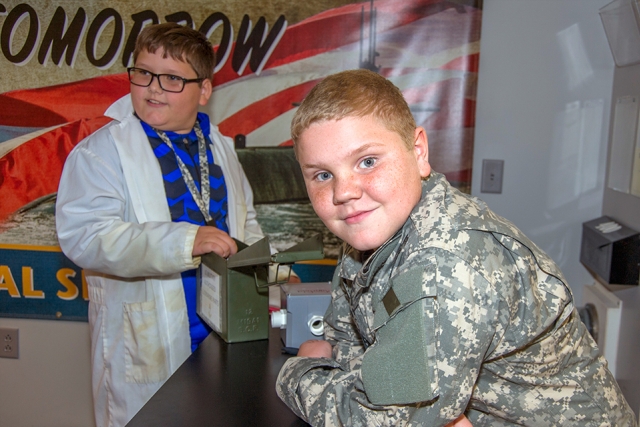 Students from Fairview Elementary in Scott County work in the Y-12 storefront during the recent grand opening at Junior Achievement of East Tennessee BizTown.
Students from Fairview Elementary in Scott County work in the Y-12 storefront during the recent grand opening at Junior Achievement of East Tennessee BizTown.
Consolidated Nuclear Security, LLC (CNS) officials were on hand, along with students from Scott County’s Fairview Elementary School, for the opening of JA BizTown’s newest resident, CNS. CNS and the Atomic Trades and Labor Council worked together with Junior Achievement to create a shop that mirrors the Y‑12 mission.
“Much like our work environment at Y‑12, we have designed the CNS BizTown business to reflect all the parties involved in successfully fulfilling a mission,” said Bill Tindal, Y‑12 site manager. “From the CEO to the Protective Force officers to the engineers and trade skills, it takes everyone working together to get the job done, and we hope this BizTown storefront helps young people learn about incorporating teamwork to safely and securely achieve their mission.”
JA BizTown gives young students the opportunity to be part of a community, interview for jobs, work in groups, run a business, and even be mayor. Fourth grader A. J. McCloud was elected mayor of BizTown and read a proclamation officially declaring: “Y‑12 National Security Complex is OPEN for business!”
“It’s great to see young people learning entrepreneurship and getting a hands‑on chance to put what they’ve learned into action,” said Tom Hayden, CNS senior director for Safeguards and Security and a JA of East Tennessee board member.
JA BizTown was established in 2008. Since then, more than 50,000 East Tennessee children have had the chance to be citizens and participate in the activities.
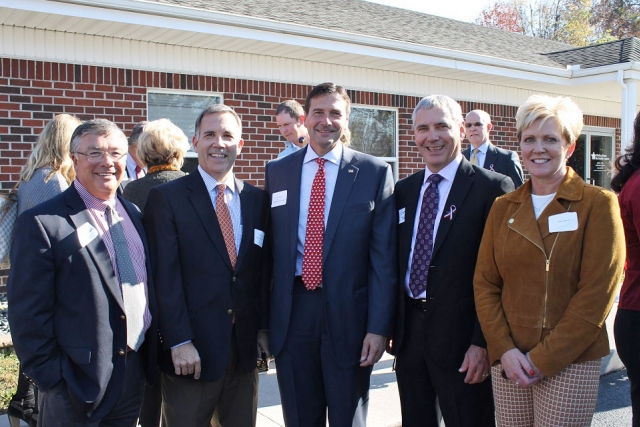 Left to right: Consolidated Nuclear Security’s Gene Patterson, Jason Bohne, and Gene Sievers join Mitch Steenrod (center) and Debby Steenrod to celebrate the opening of the new behavioral care treatment facility for veterans and active military at the Helen Ross McNabb Center.
Left to right: Consolidated Nuclear Security’s Gene Patterson, Jason Bohne, and Gene Sievers join Mitch Steenrod (center) and Debby Steenrod to celebrate the opening of the new behavioral care treatment facility for veterans and active military at the Helen Ross McNabb Center.
Representatives of Consolidated Nuclear Security, LLC (CNS), officials with Helen Ross McNabb Center (HRMC) and others took part in the opening of a new behavioral care treatment facility, which fills gaps in services for veterans and active military members in East Tennessee.
CNS donated funds to support development and operation of the Helen Ross McNabb Military Services Facility. The Helen Ross McNabb Foundation and Mitch and Debby Steenrod also provided funds to ensure the continuity of services through this program.
“We thank Consolidated Nuclear Security for its generosity and compassion for veterans in our community,” said Houston Smelcer, vice president of Development and Government Relations for the Helen Ross McNabb Foundation.
Under the new program, the Center will collaborate with the Veterans Administration to identify individuals who are experiencing mental health and/or substance abuse disorders and get them
individual and family therapy.
“We aim to serve those who have courageously served our country to guarantee they have access to the resources and support they need to continue healthy and purposeful living,” said Jerry Vagnier, HRMC president and chief executive officer.
Highly trained master’s-level clinicians will be employed to provide treatment services. Clinicians will be certified through the National Council for Behavioral Health as “veteran behavioral health providers.”
The services will include counseling, couples counseling, and family counseling for those experiencing mental health issues, including post-traumatic stress, anxiety, and depression.
These services will be available to any service member, spouse, or family—regardless of his or her discharge status or length of service in any branch of the armed forces—and will be provided at no cost.
“Without the support of organizations like CNS, we could not provide this vital service to our area veterans,” Smelcer said.
“Veterans’ issues are a major focus of CNS, which employs many veterans at Y-12 in Oak Ridge and Pantex in Amarillo, Texas,” said Jason Bohne, senior director of CNS Communications and Public Affairs. “CNS is honored to assist veterans and active military whose service helps keep America free.” he added.
CNS’s support of the treatment program is part of an ongoing partnership with HRMC and its effort to meet the unique needs of those “who served.” In 2015, CNS provided funding for the Center’s Veterans Housing project.
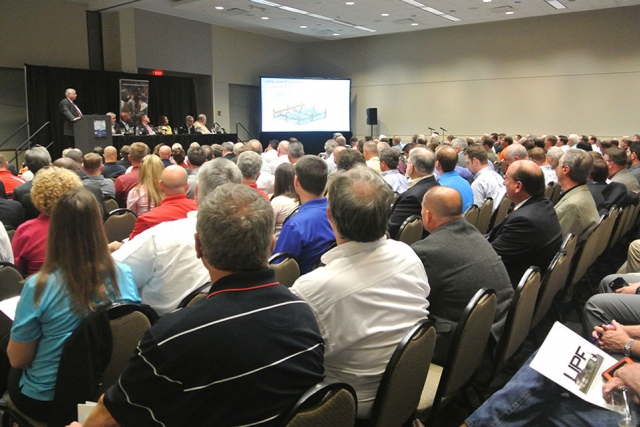 UPF Procurement and Engineering presented at an informational forum for potential vendors on Oct. 13 in Knoxville following the Energy, Technology and Environmental Business Association conference.
UPF Procurement and Engineering presented at an informational forum for potential vendors on Oct. 13 in Knoxville following the Energy, Technology and Environmental Business Association conference.
Y-12 bookended this year’s Energy, Technology and Environmental Business Association (ETEBA) conference at the Knoxville Convention Center. From the ceremonial ribbon cutting at the kick off to a post-conference forum, Y-12 officials interacted with the local business community.
CNS Vice President and Y-12 Site Manager Bill Tindal helped open the three-day conference. During the conference, Cindy Morgan, CNS’s senior supply chain manager, participated on a panel to help educate local and small businesses on Y-12 subcontracting opportunities. CNS Infrastructure Programs Director Steve Laggis spoke separately about risk reduction efforts at Y-12’s legacy facilities. Laggis shared progress on projects to protect existing facilities until large-scale decontamination and decommissioning efforts can begin, which includes recent progress to reseal the roofs on three buildings with a commercial foam roofing material.
Following the conference, personnel from the Uranium Processing Facility project spoke to a standing-room-only crowd at an informational forum for potential vendors in Knoxville. More than 300 business representatives hoping to do business with UPF attended the forum.
After a presentation from UPF Procurement Director Rich Brown and a question-and-answer period, potential vendors had an opportunity to speak with procurement and engineering representatives about upcoming bid packages and the pre-qualification and registration processes.
UPF procurement will kick into overdrive during the next couple of years, with the majority of purchases for the project made between 2017 and 2019.
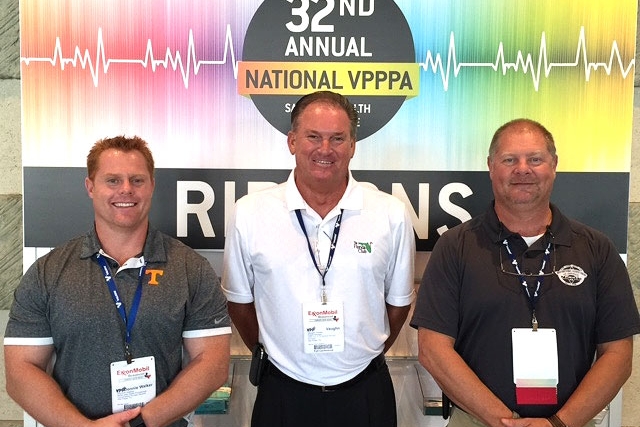 From left, Don Walker of Y‑12 Safeguards and Security; Vaughn Hooks, Y-12 Voluntary Protection Program facilitator; and Keith McCoy, Y‑12 Safeguards and Security attended the 32nd Annual National Voluntary Protection Programs Participants’ Association Safety and Health Conference, where Y-12 received a Star of Excellence.
From left, Don Walker of Y‑12 Safeguards and Security; Vaughn Hooks, Y-12 Voluntary Protection Program facilitator; and Keith McCoy, Y‑12 Safeguards and Security attended the 32nd Annual National Voluntary Protection Programs Participants’ Association Safety and Health Conference, where Y-12 received a Star of Excellence.
Y‑12 representatives brought home a star from the 32nd Annual National Voluntary Protection Programs Participants’ Association (VPPPA) Safety and Health Conference in Kissimmee, Florida, in September.
The conference gathered safety leaders from 400 industries that participate in the VPPPA. The Star of Excellence Award Y‑12 won recognizes sites that maintain a recordable injury rate that is 75 percent better than U.S. businesses in the same industry. The 2016 award is based on statistics from the 2015 calendar year.
Brad Davy, director of Department of Energy’s Office of Worker Safety and Health Assistance, presented the award. “This award provided by the Department of Energy recognizes a contractor for excellence in safety and health systems going above and beyond requirements and demonstrating effective management commitment and employee involvement while applying the Integrated Safety Management System,” he said.
The Voluntary Protection Program (VPP) is the result of cooperation between companies, the Occupational Safety and Health Administration, state OSHA leaders, members of congress, DOE, and the Department of Defense.
CNS Senior Director of Environment, Safety, and Health Chris Cantwell said the award criteria is a gateway but is not the destination. “The Star criteria is a threshold, but it doesn’t mean that we’re satisfied with that — that we’re finished,” Cantwell said. “We will strive to improve far beyond the minimum.”
Y-12 VPP Facilitator Vaughn Hooks noted that the award criteria considers factors in addition to injury incident rates. “Demonstration of the extent and effect of the site’s mentoring and outreach efforts is one of the criteria to be recognized for the Star of Excellence award, and Y‑12 has a long tradition of investing in its local community through volunteerism and charitable contributions,” Hooks said.
When the award plaque was presented to Y‑12 Site Manager Bill Tindal during a recent managers meeting, he pointed out that the award belongs to all Y‑12 employees for their efforts to work safely every day.
Don Walker of Y‑12 Safeguards and Security’s Protective Force Operations and Training completed the Special Government Employee Program before the conference began. This program allows industry employees to work alongside OSHA and DOE during VPP on‑site evaluations. Not only does this innovative program benefit OSHA by supplementing its on‑site evaluation teams, but it gives industry and government an opportunity to work together and share views and ideas.
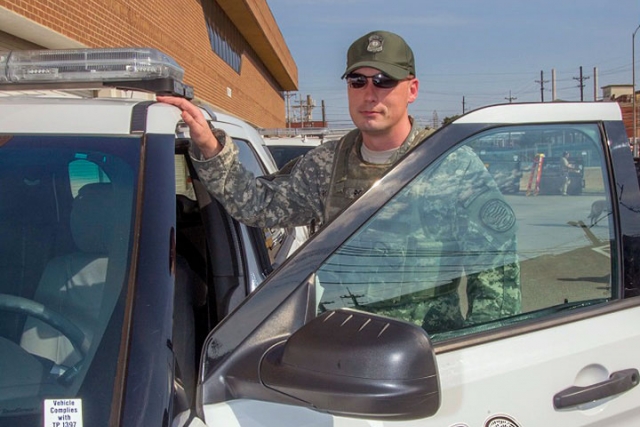 Steve Robison is an Army veteran and one of the 32 graduates from the Security Police Officer Tactical Response Force I class held this summer in Oak Ridge.
Steve Robison is an Army veteran and one of the 32 graduates from the Security Police Officer Tactical Response Force I class held this summer in Oak Ridge.
Experience is the teacher of all things—Julius Caesar
Steve Robison doesn’t focus on what he’s lost, only what he’s gained, including a wealth of experience, and for the Army veteran, experience has a great deal to do with being a good team member.
Robison is one of the 32 graduates from the Tactical Response Force I class held this summer in Oak Ridge. These graduates, a majority of whom will be security police officers at Y-12, endured the southern heat and humidity to demonstrate their weapon-handling expertise. They also knocked the top off the classroom work with an average of 96 percent on written exams.
“My history with the military gave me a good background for this position,” he said. “I was in the Army until 2005, when I lost my leg. After I retired in 2006, I became a civilian instructor for the Army teaching basic combat tactics, so the requirements are within my realm of experience.”
Robison draws from his military experience to not only to excel in the field and the classroom but also to make himself a great team member. “Our class worked together to succeed, and that follows through into our positions as SPOs,” he said. “We’re all proud to help protect one of our nation’s security assets, and we’re all excited to get to work with such a wealth of knowledge at Y-12.”
While the mission at Y-12 is somewhat different from his military days, Robison says integrating the additional concepts of law enforcement into his combat-based background is an exciting challenge.
“The mix of military and law enforcement backgrounds here is a great asset to our mission,” he said. “As our class integrates into the security team, we’re learning as much as we can from the expertise available here at Y-12. Personally, I’m excited to get back to work with people of a like mindset.”
Robison said rejoining a familiar team not only appealed to him, but the TRF I course allowed him to challenge myself mentally and physically. “Pro Force is a really good career field, and this is an excellent program,” he said. No special considerations were given to him for physical requirements, such as the mandatory mile run that must be completed in eight minutes and thirty seconds or less. Robison also proudly stated that each member of his class passed their weapons qualification on the first attempt with a score of 320 or higher out of 400.
As much as he enjoyed joining the Y-12 team, Director of Pro Force Operations and Training Eric Belcher says Y-12 was very glad to have Robison enroll in Basic Security Police Officer Training. “Steve and this class performed exceptionally well and worked extremely hard. These SPOs are critical to our mission, and the American people depend on us.” NNSA Production Office Manager Geoff Beausoleil agreed. “I talked with the class at their graduation, and I was struck by their dedication, professionalism and patriotism. Steve is humble with a great sense of humor—he is an impressive individual.”
As for Robison’s home team, he says his wife and children are enjoying the beauty of the area. It would seem Robison is well on his way to creating another chapter in his book of experience, and Y-12 and East Tennessee have gained an amazing team member.
